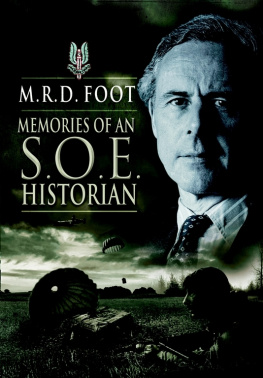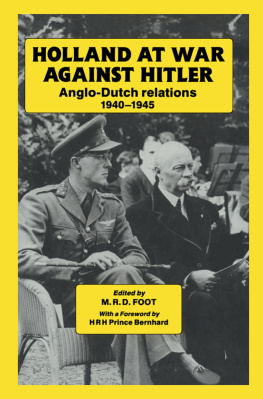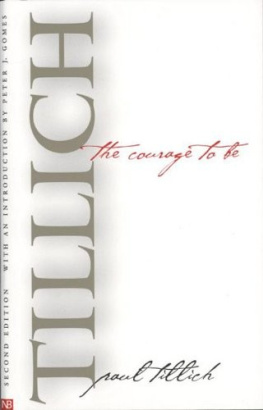First published in Great Britain in 1978 by
Eyre Methuen Ltd
Reprinted by Magnum 1980
This revised and updated edition published in 2003 by
LEO COOPER
an imprint of Pen & Sword Books,
47 Church Street,
Barnsley
South Yorkshire,
S70 2AS
Copyright M.R.D. Foot, 2003
ISBN 0 85052 965 4
eISBN 978 1 78337 969 9
A catalogue record for this book is available from the British Library.
Typeset in 11/14pt Sabon by
Phoenix Typesetting, Burley-in-Wharfedale, West Yorkshire.
Printed in England by CPI UK
Preface
If courage is, as Winston Churchill has said, the quality that guarantees all others, it also takes many forms. For Lord Moran, in The Anatomy of Courage, it was the kind brought out by the desperate battles of the Flanders trenches. And, for Robert Graves, not only in feats of action. In Goodbye to All That he describes how a fellow officer, Captain A.L. Samson of the Royal Welch Fusiliers, fell mortally wounded and groaning some twenty yards out from the front line. He was so respected that three men were killed and another four wounded in trying to get him back. His own orderly reached him, but Samson sent him back with an apology for making so much noise, and then went silent. When at dusk Graves found him he was dead, hit in seventeen places and with his knuckles forced into his mouth to stop himself crying out and attracting any more men to their death. Such exemplary courage is not confined to the battlefield I have seen the same spirit in an elderly woman, irremediably bedridden for years with an unmending thigh bone so broken that the end projected to her skin, and bearing it uncomplainingly so as to be less burden to those around her.
Few men have spoken of courage with such understanding as Lord Slim. In a 1946 broadcast, he remarked that environment was important: It is the lands where nature is neither too easy nor too cruel, where a man must work hard to live but where his efforts and enterprise can bring him great rewards, that breed courage and where it becomes a natural tradition. And dont run away with the idea that this limits courage to northern Europe and North America. Believe me and Ive fought both with them and against them some of the bravest races in the world arent white at all. Again, Winston Churchill, contemplating the Dervish dead after Omdurman wrote: yet these were as brave men as ever walked the earth destroyed, not conquered, by machinery. And since we remember with horror the atrocities committed by the Germans, let us recall that their fighting men were not without courage. When the Tirpitz was capsized by our bombers, the doomed men trapped inside the hull were heard singing Deutschland ber Alles.
Lord Slim movingly emphasized that courage in battle is only one form: the fighting man is the last to claim a monopoly in courage In the retreat in Burma in 1942, I was deeply proud of the troops Yet the outstanding impression of courage I carried away from that desperate campaign was from the Indian women refugees. Day after day, mile after mile, they plodded on, through dust or mud, their babies in their arms, children clinging to their skirts, harried by ruthless enemies, strafed from the air, shelterless, caught between the lines in every battle, yet patient and uncomplaining, devoted, thinking only of their families so very brave.
Beyond physical courage lies moral courage and it would be hard to disagree with Lord Slims observation that this is much the rarer. How often, for example, do we see a political leader risking his future as Robert Peel did when as Prime Minister he turned against his party to repeal the Corn Laws: To incur the heaviest responsibility and to be at the same time the tool of a party that is to say, to adopt the opinions of men who have not access to your knowledge and could not profit by it if they had would be an odious servitude to which I never would submit.
But if we can immediately recognize moral courage when we encounter it at any political level from the village Hampden up to Robert Peel, some of its manifestations are less obvious. I have in mind, for example, the courage of those theoretical physicists who stood by their calculations that the exploding of a thermonuclear bomb would not start a reaction that would burn up all the hydrogen in the oceans and thus exterminate humanity.
The courage of which Professor Foot writes with such understanding and warmth is the kind brought out by the Resistance movements against the Nazis in the Second World War and he has taken six examples. Of these, four (Jean Moulin and Marie-Madeleine Fourcade in France, Andre de Jongh in Belgium and Witold Pilecki in Poland) were in their own countries when they were overrun by the Germans, and they must first have had to face the agonizing moral decision of whether to stay or whether to escape in the hope of continuing the fight from outside. Has any great playwright, incidentally, debated such a situation? The other two (Harry Peulev and Victor Gerson, respectively of French and Jewish extraction) were of British nationality; Peulev a television cameraman at Alexandra Palace and Gerson a dealer in fine rugs in Paris who escaped to England during the German advance in France.
Their operations were of very different kinds, and illustrate the different forms that resistance can take. It is this that justifies Professor Foots title Six Faces of Courage, for his six figures really have much in common in the courage they exhibit, which was called forth by circumstances different from any that I have cited earlier, a distinguishing feature being the isolation in which resistance workers had to operate. This was part of the price that they had to pay for whatever degree of security they could achieve in a treacherous environment. Only rarely did they know, for example, whether the information that they had obtained at great risk could find its way back to London and whether we would act upon it. I warmly recall a day in 1942 when I read on a badly focused microfilm a report of some Belgian agents about the German nightfighter radar stations in their area. After mentioning that in reconnoitring one station in their area they had been shot at by a sentry fortunately with more zeal than accuracy, they concluded:
As far as our work is concerned, it would be helpful if we knew to what extent you and the British services are interested. We have been working so long in the dark that any reaction from London about our work could be welcome to such obscure workers as ourselves. We hope that you will not take this in bad part since, whatever may happen, you can rely on our entire devotion and on the sacrifice of our lives.
Fortunately in this particular case we were shortly able to give them tangible evidence that their work was not in vain by bombing the local nightfighter headquarters, and later by the dropping of Window to confuse the radars. But there must have been far too many other instances where there was no visible response to acts of the greatest gallantry, and where men and women died without ever knowing whether their sacrifice had been worthwhile.
There were primarily three aspects of resistance: the obtaining of intelligence, the assisting of Allied servicemen escaping from enemy-held territory, and the sabotage of German installations and resources. My own concern was primarily with intelligence and my closest connection with any of Professor Foots six examples was with the incredibly brave Marie-Madeleine Fourcade. Hers is a magnificent story which she herself has told admirably in Noahs Ark. In it she reproduces a copy of a report that was forwarded by her organization to us in London in August 1943, which told us about the organization that the Germans were setting up for the V-bombardment of London ten months later. It contained so much inner detail concerning the organization (such as the regimental designation and the commanding officers name, and the kinds of passes needed for entry to Peenemnde) that I immediately asked who the source was, but all that Marie-Madeleine could tell me was that it was Une jeune fille la plus remarquable de sa gnration. After the war, I learnt her name: she was Jeannie Rousseau, known to her network as Amniarix, and equally brave with Marie-Madeleine. At the time of her report she was twenty-three years old, and had been working for the Resistance since she was twenty. Youth was indeed a feature common to many resistance workers, although some, of course, were of maturer years, such as Jean Moulin and Witold Pilecki. Marie-Madeleine herself, at the head of an organization of between 2,000 and 3,000 workers was only thirty and Dede de Jongh, whose famous Comet escape line brought out seven hundred Allied airmen, was in her mid-twenties.














